
FlowiseAI is an Open Source Graphic User Interface to build your customized LLM flow on LangChain. LLM (Large Language Model): A large language model (LLM) is a deep learning algorithm that can perform a variety of natural language processing (NLP) tasks. These models (also referred to as neural networks) are typically built on transformer architectures and are characterized by their extensive training on massive datasets. Large language models (LLMs) like GPT-3 and similar models can be used to develop a variety of applications across different domains e.g. LLM Chains, GenApps, Prompt Chaining etc. In this step by step guide I will show you how to install FlowiseAI on your Synology NAS using Docker & Portainer.
STEP 1
Please Support My work by Making a Donation.
STEP 2
Install Portainer using my step by step guide. If you already have Portainer installed on your Synology NAS, skip this STEP. Attention: Make sure you have installed the latest Portainer version.
STEP 3
Make sure you have a synology.me Wildcard Certificate. Follow my guide to get a Wildcard Certificate. If you already have a synology.me Wildcard certificate, skip this STEP.
STEP 4
Go to Control Panel / Login Portal / Advanced Tab / click Reverse Proxy. Follow the instructions in the image below.
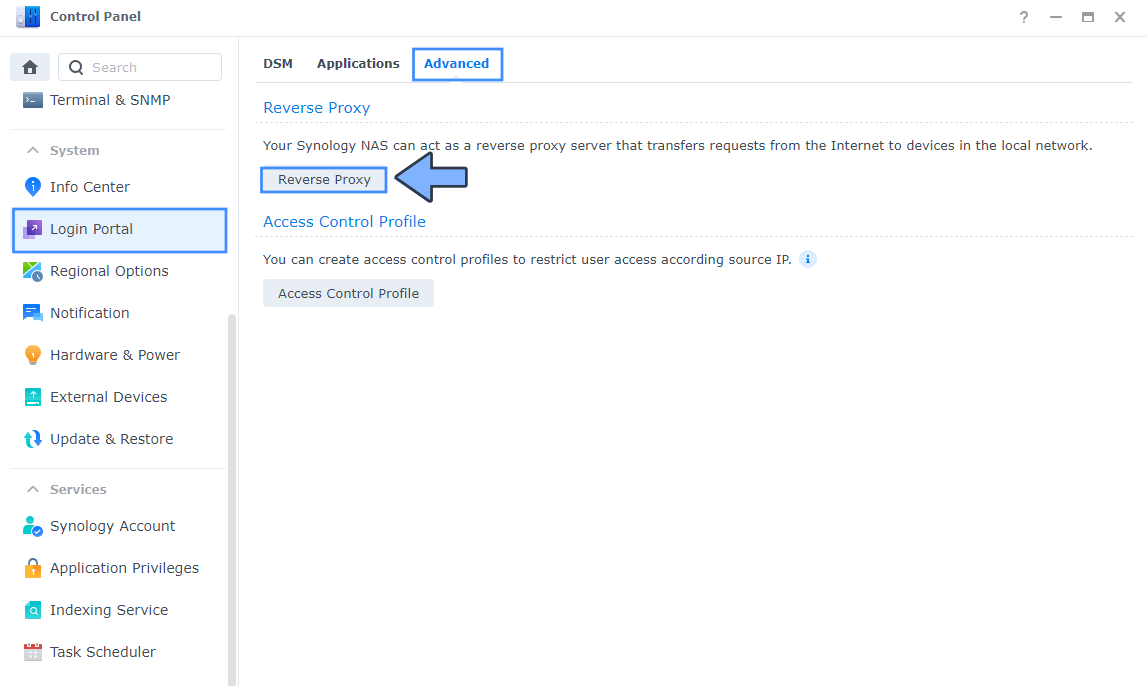
STEP 5
Now click the “Create” button. Follow the instructions in the image below.
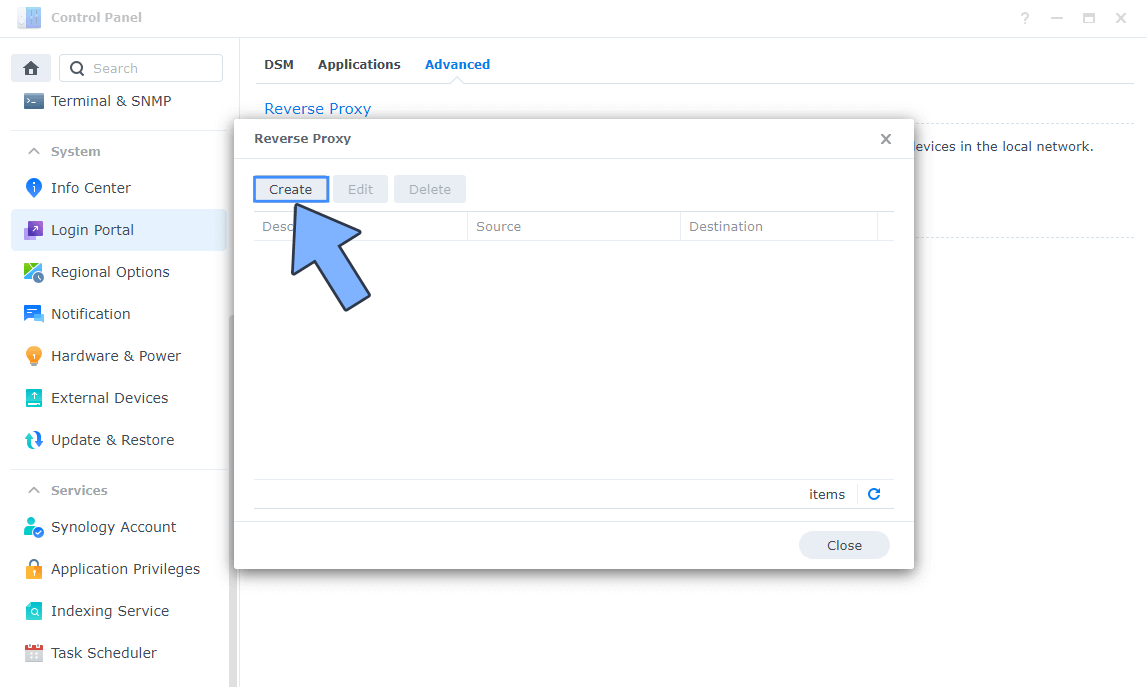
STEP 6
After you click the Create button, the window below will open. Follow the instructions in the image below.
On the General area, set the Reverse Proxy Name description: type in FlowiseAI. After that, add the following instructions:
Source:
Protocol: HTTPS
Hostname: flowiseai.yourname.synology.me
Port: 443
Check Enable HSTS
Destination:
Protocol: HTTP
Hostname: localhost
Port: 8459
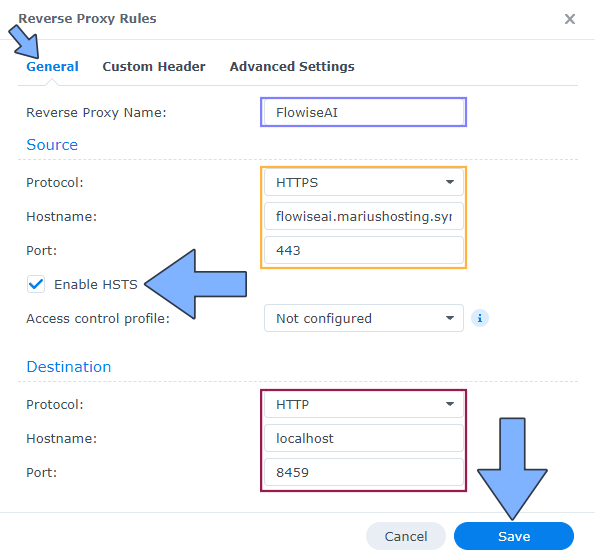
STEP 7
On the Reverse Proxy Rules click the Custom Header tab. Click Create and then, from the drop-down menu, click WebSocket. After you click on WebSocket, two Header Names and two Values will be automatically added. Click Save. Follow the instructions in the image below.

STEP 8
Go to Control Panel / Network / Connectivity tab/ Check Enable HTTP/2 then click Apply. Follow the instructions in the image below.
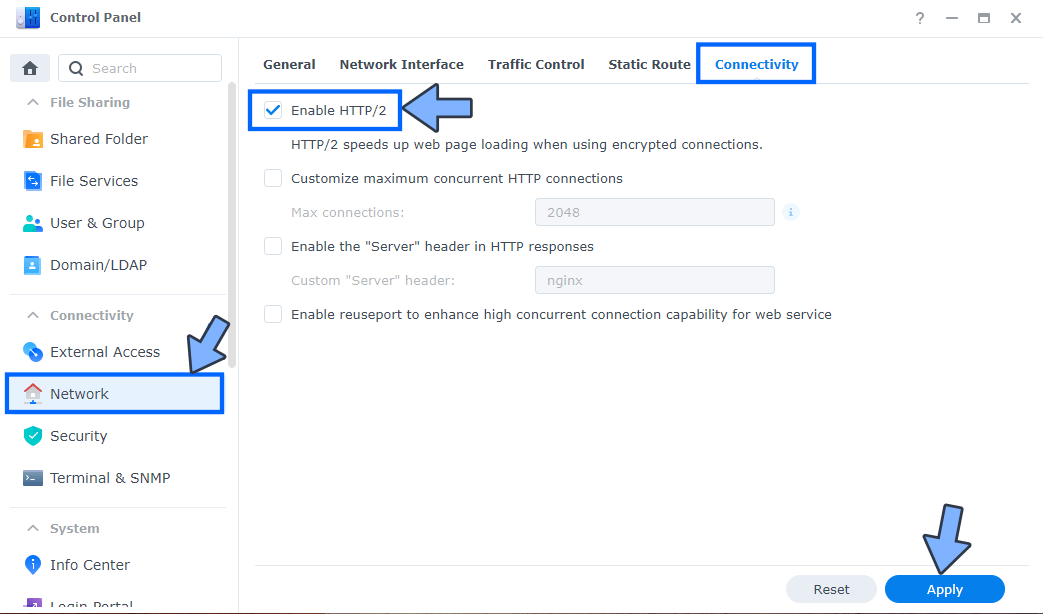
STEP 9
Go to Control Panel / Security / Advanced tab/ Check Enable HTTP Compression then click Apply. Follow the instructions in the image below.

STEP 10
Go to File Station and open the docker folder. Inside the docker folder, create one new folder and name it flowiseai. Follow the instructions in the image below.
Note: Be careful to enter only lowercase, not uppercase letters.
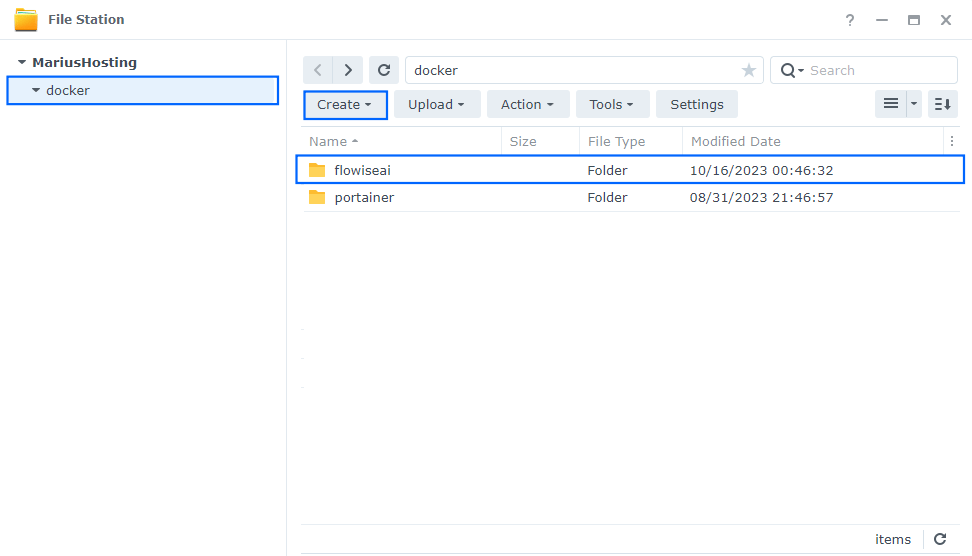
STEP 11
Now create two new folders inside the flowiseai folder that you created at STEP 10 and name them data and db. Follow the instructions in the image below.
Note: Be careful to enter only lowercase, not uppercase letters.
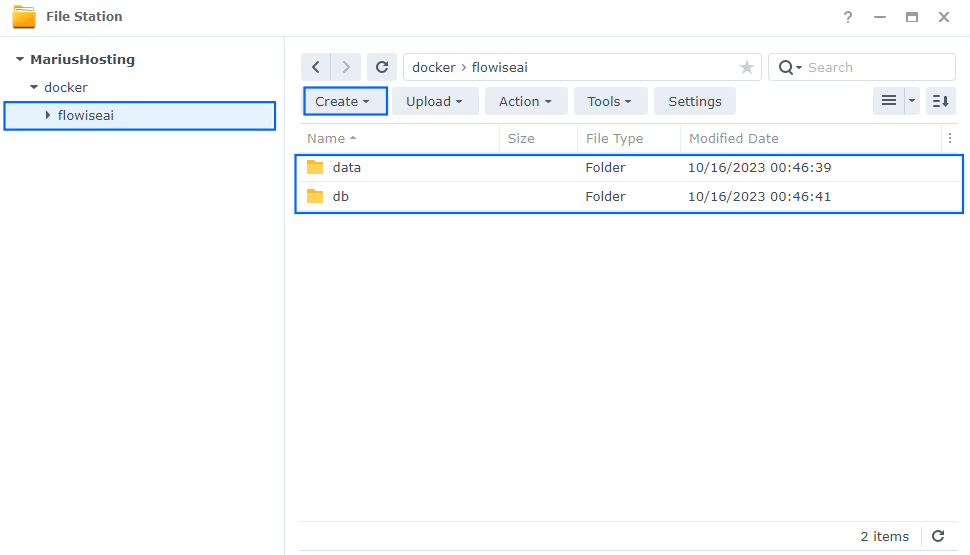
STEP 12
Follow my step by step guide on how to activate SMTP for your Gmail account. This step is mandatory. Note: If you don’t want to use the easiest way for SMTP with Google and you already have SMTP details from your own Mail Server, you can just skip this STEP and use your personalized email SMTP details instead.
STEP 13
Log into Portainer using your username and password. On the left sidebar in Portainer, click on Stacks then + Add stack. Follow the instructions in the image below.

STEP 14
In the Name field type in flowiseai. Follow the instructions in the image below.
services:
db:
image: postgres:17
container_name: FlowiseAI-DB
hostname: flowise-db
security_opt:
- no-new-privileges:true
healthcheck:
test: ["CMD", "pg_isready", "-q", "-d", "flowise", "-U", "flowiseuser"]
timeout: 45s
interval: 10s
retries: 10
volumes:
- /volume1/docker/flowiseai/db:/var/lib/postgresql/data:rw
environment:
POSTGRES_DB: flowise
POSTGRES_USER: flowiseuser
POSTGRES_PASSWORD: flowisepass
restart: on-failure:5
flowise:
image: flowiseai/flowise:latest
container_name: FlowiseAI
hostname: flowise
security_opt:
- no-new-privileges:true
healthcheck:
test: wget --no-verbose --tries=1 --spider http://localhost:3000
ports:
- 8459:3000
volumes:
- /volume1/docker/flowiseai/data:/root/.flowise:rw
environment:
DEBUG: false
PORT: 3000
FLOWISE_USERNAME: marius
FLOWISE_PASSWORD: mariushosting
APP_URL: https://flowise.yourname.synology.me
JWT_AUTH_TOKEN_SECRET: dOxZYTTZgXKMHkqLBIQVImayQXAVWdzGBPuFJKggzcgvgPJPXpWzqzKaUOIOGGIr
SMTP_HOST: smtp.gmail.com
SMTP_PORT: 587
SMTP_USER: Your-own-gmail-address
SMTP_PASSWORD: Your-own-app-password
SMTP_SECURE: STARTTLS
SENDER_EMAIL: Your-own-gmail-address
DATABASE_PATH: /root/.flowise
APIKEY_PATH: /root/.flowise
SECRETKEY_PATH: /root/.flowise
LOG_LEVEL: info
LOG_PATH: /root/.flowise/logs
DATABASE_TYPE: postgres
DATABASE_PORT: 5432
DATABASE_HOST: flowise-db
DATABASE_NAME: flowise
DATABASE_USER: flowiseuser
DATABASE_PASSWORD: flowisepass
depends_on:
db:
condition: service_healthy
restart: on-failure:5
Note: Before you paste the code above in the Web editor area below, change the value for FLOWISE_USERNAME. Type in your own username. marius is an example for a username.
Note: Before you paste the code above in the Web editor area below, change the value for FLOWISE_PASSWORD. Type in your own password. mariushosting is an example for a password.
Note: Before you paste the code above in the Web editor area below, change the value for APP_URL and type in your own synology.me DDNS with https:// at the beginning that you have previously created at STEP 6.
Note: Before you paste the code above in the Web editor area below, change the value for JWT_AUTH_TOKEN_SECRET. (Generate your own Random 64 length JWT_AUTH_TOKEN_SECRET.)
Note: Before you paste the code above in the Web editor area below, change the value for SMTP_USER and type in your own Gmail address. STEP 12.
Note: Before you paste the code above in the Web editor area below, change the value for SMTP_PASSWORD and type in your own Gmail app password. STEP 12.
Note: Before you paste the code above in the Web editor area below, change the value for SENDER_EMAIL and type in your own Gmail address. STEP 12.
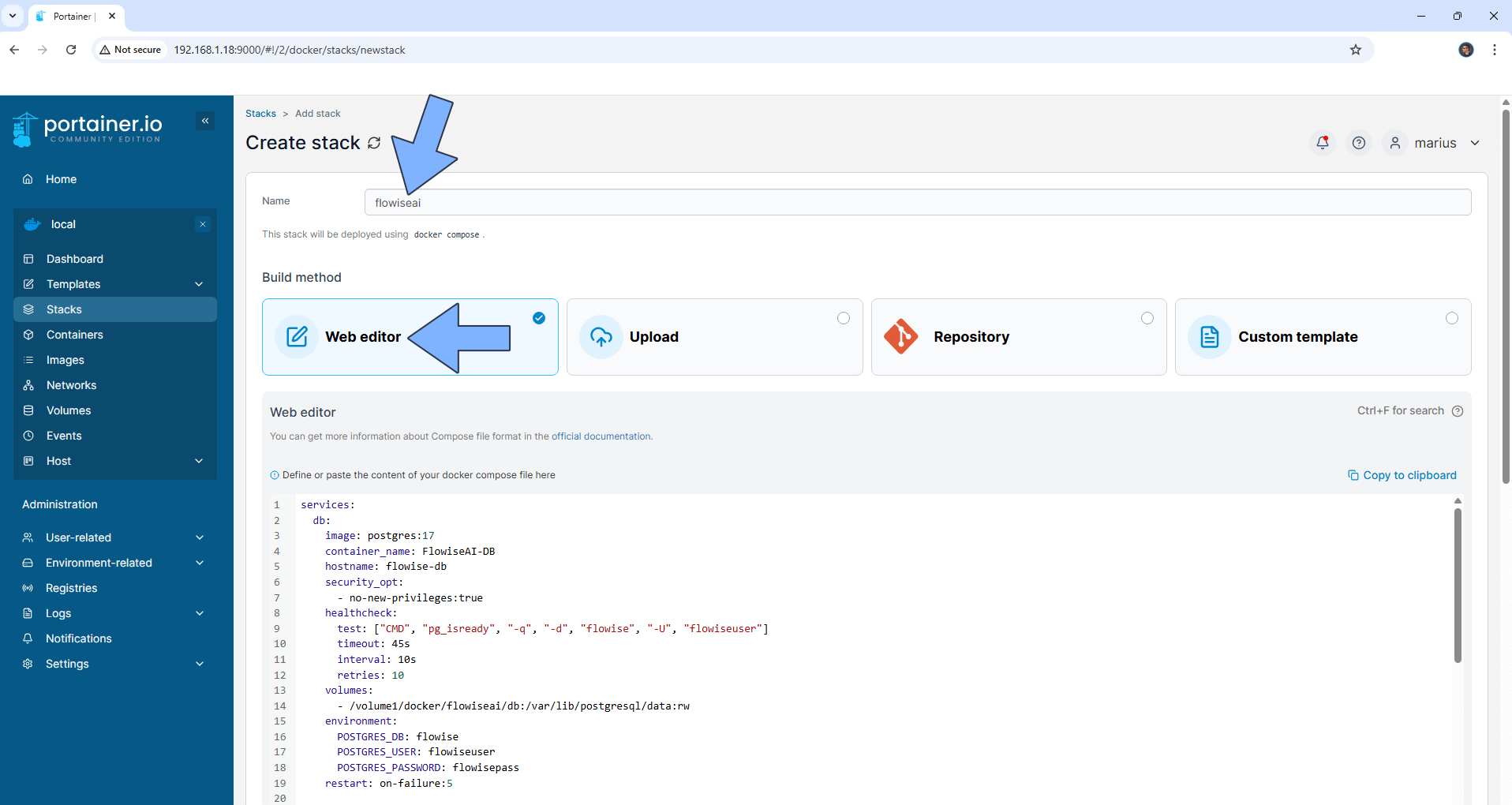
STEP 15
Scroll down on the page until you see a button named Deploy the stack. Click on it. Follow the instructions in the image below. The installation process can take up to a few minutes. It will depend on your Internet speed connection.
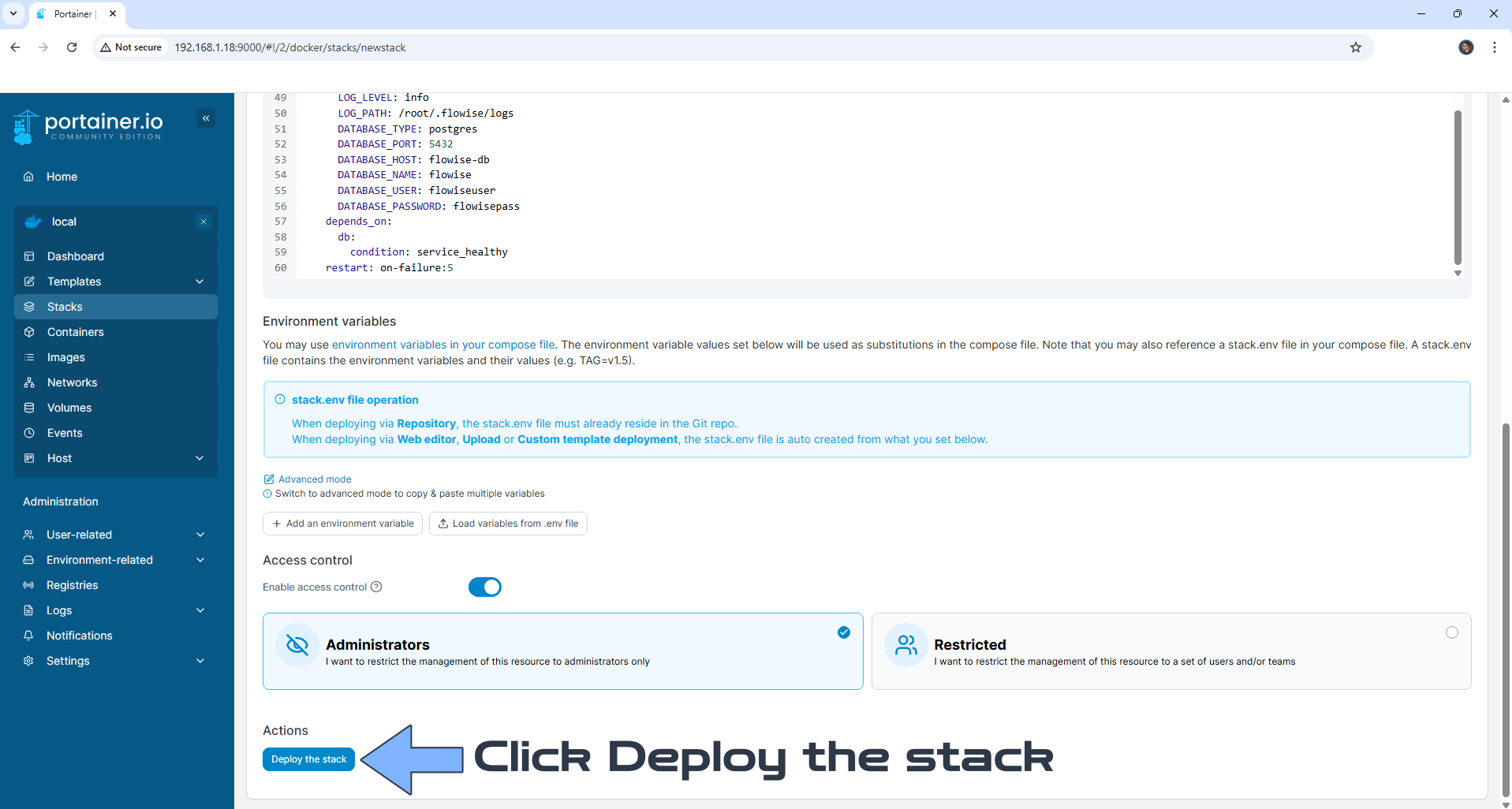
STEP 16
If everything goes right, you will see the following message at the top right of your screen: “Success Stack successfully deployed“.
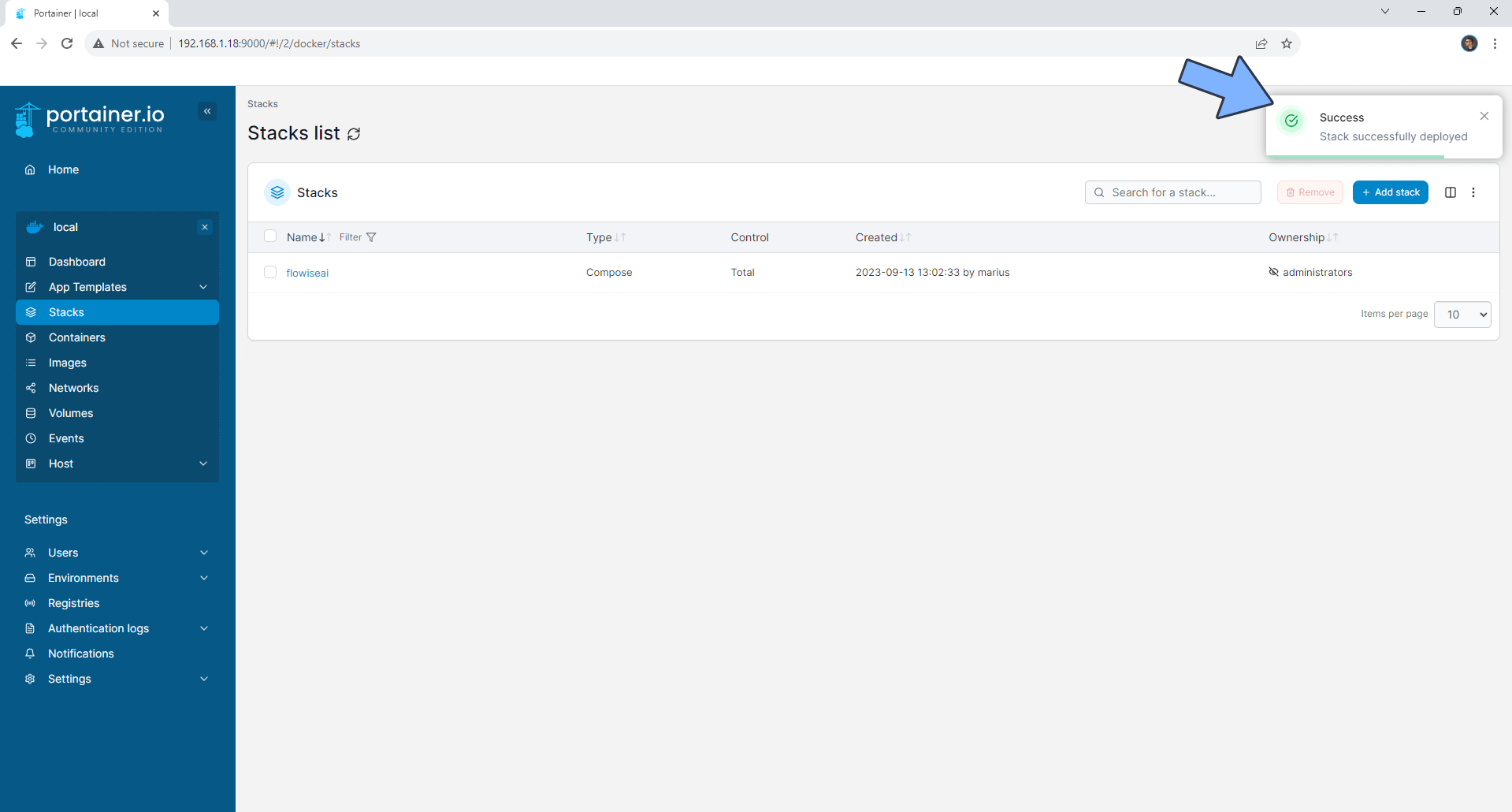
STEP 17
🟢Please Support My work by Making a Donation. Almost 99,9% of the people that install something using my guides forget to support my work, or just ignore STEP 1. I’ve been very honest about this aspect of my work since the beginning: I don’t run any ADS, I don’t require subscriptions, paid or otherwise, I don’t collect IPs, emails, and I don’t have any referral links from Amazon or other merchants. I also don’t have any POP-UPs or COOKIES. I have repeatedly been told over the years how much I have contributed to the community. It’s something I love doing and have been honest about my passion since the beginning. But I also Need The Community to Support me Back to be able to continue doing this work.
STEP 18
Now open your browser and type in your HTTPS/SSL certificate like this https://flowiseai.yourname.synology.me In my case it’s https://flowiseai.mariushosting.synology.me If everything goes right, you will see the FlowiseAI login page. Type in your own Username (FLOWISE_USERNAME) and
Password (FLOWISE_PASSWORD) that you have previously added at STEP 14. Type in your own Administrator Name, Email and Password. Click Sign Up. Follow the instructions in the image below.
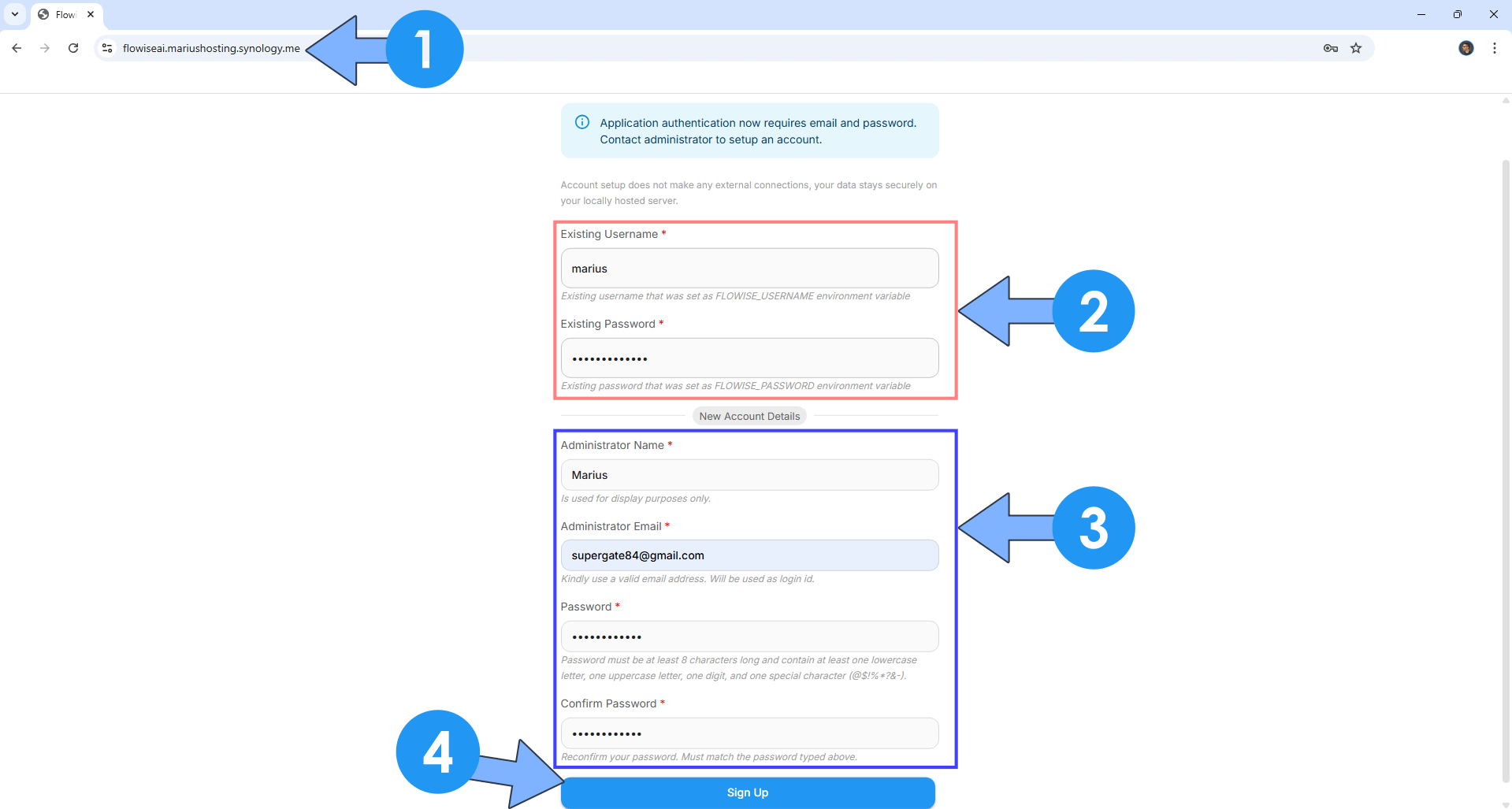
STEP 19
At the top right of the page, you can switch the FlowiseAI theme to Dark. Follow the instructions in the image below.
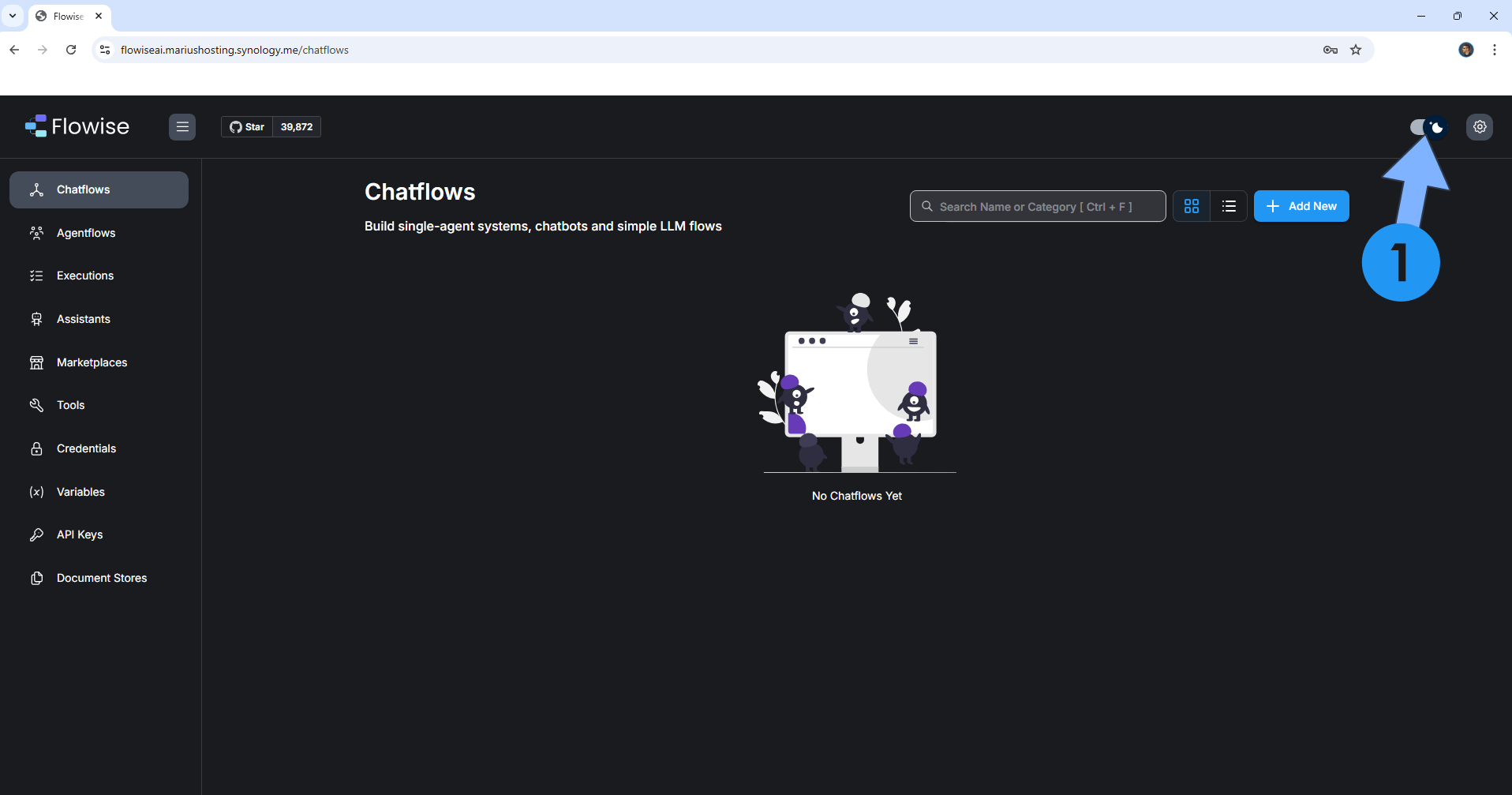
STEP 20
Your FlowiseAI dashboard at a glance!
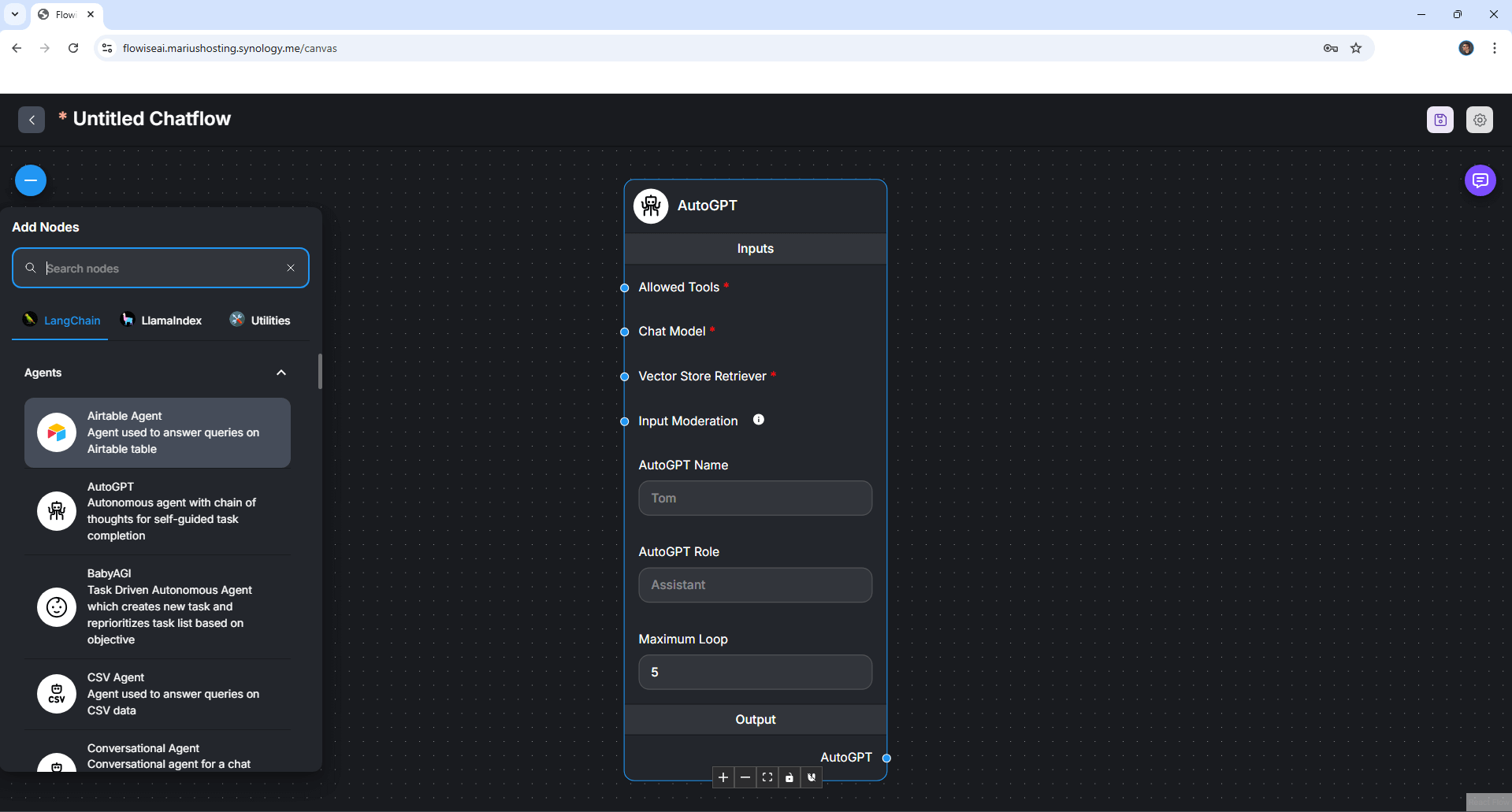
Enjoy FlowiseAI!
If you encounter issues by using this container, make sure to check out the Common Docker issues article.
Note: Can I run Docker on my Synology NAS? See the supported models.
Note: How to Back Up Docker Containers on your Synology NAS.
Note: Find out how to update the FlowiseAI container with the latest image.
Note: How to Free Disk Space on Your NAS if You Run Docker.
Note: How to Schedule Start & Stop For Docker Containers.
Note: How to Activate Email Notifications.
Note: How to Add Access Control Profile on Your NAS.
Note: How to Change Docker Containers Restart Policy.
Note: How to Use Docker Containers With VPN.
Note: Convert Docker Run Into Docker Compose.
Note: How to Clean Docker.
Note: How to Clean Docker Automatically.
Note: Best Practices When Using Docker and DDNS.
Note: Some Docker Containers Need WebSocket.
Note: Find out the Best NAS Models For Docker.
Note: Activate Gmail SMTP For Docker Container
This post was updated on Friday / July 4th, 2025 at 1:20 AM
